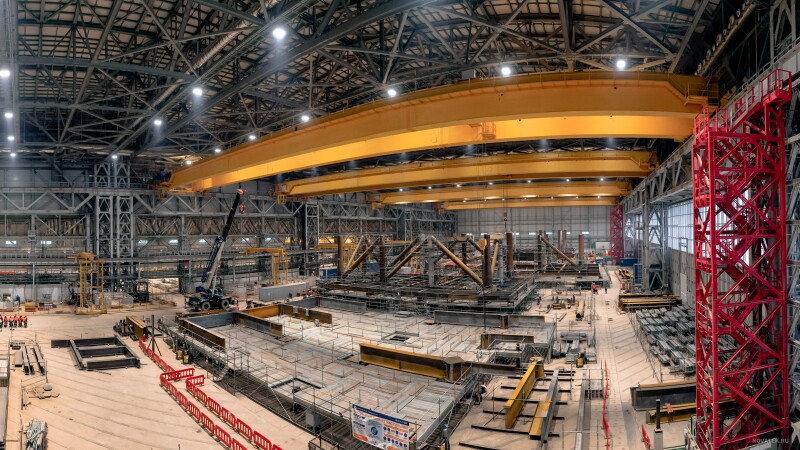Russia’s largest independent gas producer, Novatek, has discovered a new gas condensate field after having tested its first exploration well within the Bukharinskiy license area adjacent to the company’s Trekhbugorniy license area in the Gydan Peninsula, expanding the company’s resource base as record imports of Russian LNG flowed to Europe in 2022.
Novatek’s Arctic LNG 1 subsidiary discovered the new field with estimated recoverable reserves of 52 Bcm of natural gas and 2 million tons of liquids under the Russian reserve reporting standards, as confirmed by the State Reserves Commission, Novatek reported.
Named “Girya” after geologist Novatek co-founder Viktor Girya, the discovery boosts the resource base for the company’s Arctic LNG 1 project, which is in the exploration stage and, if pursued, would unlikely be realized before 2030.
Arctic LNG 1 would be Novatek’s fourth LNG facility, if built.
Meanwhile, Novatek had planned to launch the first of the three trains planned for its 19.8 mtpa Arctic LNG 2 project in 2023 (its second LNG plant). This year the company also planned to make a final investment decision on the 5 mtpa Obsky LNG facility, a third plant to be built using Russian technologies and domestically manufactured equipment.
The development of Arctic LNG 1 would then follow as the company pursues its goal of more than tripling its current LNG production to 70 mtpa by 2030.
Sanctions Block Access to Technology When Domestic Doesn’t Suit
Meeting these benchmarks could be problematic, however, given that Western sanctions
brought on by Russia’s invasion of Ukraine have caused a mass exodus of key western technology companies with which Novatek has partnered since its first facility, Yamal LNG, dropped its first LNG in December of 2017.
For example, France’s TechnipEnergies reported in its Q3 2022 earnings statement that it had signed a framework agreement to exit the Arctic LNG 2 project with expectations of completing the process in the first half of 2023. In July, Russia’s business daily Kommersant reported that Baker Hughes had withdrawn service engineers from Yamal LNG's operations, and project engineers and equipment shipments to Arctic LNG 2 as it remained under construction.
Novatek has also struggled with its Russian-patented Arctic Cascade liquefaction technology which leverages ambient Arctic temperatures to reduce energy consumption and capital costs. Though Novatek planned to use Arctic Cascade in its future projects, it encountered issues causing it to return to western technology choices. Under sanctions now, western tech is no longer an option.
It's Still Russian: EU Substitutes Russian LNG for Pipeline Gas
Nonetheless, Novatek did report a 6.3% increase in LNG exports in 2022 over 2021 sales with a total volume of 8.45 Bcm as the EU ironically has actually pushed its Russian LNG purchases to new highs even as it has shunned Russian pipeline gas and sanctioned Russian oil out of the market.
Reuters reported in December that France’s TotalEnergies was planning to stay involved in Novatek’s flagship Yamal LNG project even as it was writing off $3.7 billion on its 19.4% equity stake in Novatek itself and tendering the resignation of its representatives to Novatek’s board of directors—Arnaud Le Foll and Dominique Marion.
Reuters quoted a source as saying that TotalEnergies would remain a partner in Yamal LNG for the time being “at the request of EU authorities” to ensure it could continue “to supply gas to Europe” via the Novatek project. TotalEnergies holds a 20% stake in the Yamal LNG joint venture with partners Novatek (50.1%), the China National Petroleum Company (20%), and Silk Road Fund (9.9%).
Novatek supplied 94% of Russian LNG purchased by the EU in 2022 from its Yamal LNG terminal and another 4% from Novatek’s small-scale facility at Vysotsk on the Baltic Sea. Gazprom shipped the last 2% from its Portovaya terminal near the Russian-Finnish border, according to the London-based Institute for Energy Economics and Financial Analysis (IEEFA).
Spain and Belgium topped the list of European importers of Russian LNG with a 55% total increase in deliveries. France and the Netherlands followed. Countries that reduced Russian LNG imports in 2022 included Croatia, Lithuania, Portugal, Sweden, and the UK whose Foreign, Commonwealth & Development office announced that as of 1 January 2023 the country would no longer buy any LNG from Moscow.
US sales of LNG to Europe soared 143% while sales from Qatar jumped 23% year on year, the IEEFA reported. France was the top importer of combined US and Russian deliveries while the UK was the top importer of Qatari LNG.

Meanwhile, Arctic LNG 1 continues to explore its future resource base in the Russian Arctic with licenses for not only the Bukharinsky block where well tests confirmed the latest discovery, but also the Trekhbugorny blocks, Geofizichesky 1, Gydansky 1 and North Gydansky blocks, plus three fields—Geofizicheskoye, Gydanskoye, and Soletsko-Khanaveiskoye.
In December, Novatek announced that another of its subsidiaries, Novatek-Yurkharovneftegas, had won the auction for a 27-year geological survey, exploration and production license for the Yeniseyskiy subsoil area in the Krasnoyarsk Territory.
The Yeniseyskiy license area is in a new, highly prospective oil and gas province with resource growth potential in the Palaeozoic and Jurassic reservoirs. The license area is adjacent to the company’s South-Leskinskiy area, Novatek reported.
Novatek operations are concentrated in Russia’s Yamal-Nenets Autonomous Region, which is said to account for 80% of Russia’s natural gas production and approximately 15% of global gas production.


